
The management of a composting plant cannot be limited to monitoring the physical quantities of the compost (temperature, humidity, oxygen), but must necessarily also include anemological analysis and knowledge of the dynamics of the air and odours.
To control the dispersion of odorous emissions, it is necessary to monitor the meteorological variables that influence the anemological regime of the site, using professional meteorological stations.
For this purpose, ACEA Ambiente has chosen to equip its own integrated composting and anaerobic digestion plant in Monetrotondo Marittimo (GR), one of the largest in Central Italy, with a compact meteorological station, with an ALL-IN-ONE sensor – that provides temperature and relative air humidity, wind speed and direction, solar radiation and barometric pressure – and a rain gauge.
The meteorological data collected are in fact used to support the air quality analyses carried out quarterly at the receptors closest to the plant.
Analysis of the dispersion of odours just a click away
The ACEA Ambiente professional meteorological station is connected to the LSI LASTEM Enviro Cube cloud platform, which allows, in addition to displaying and downloading data, historical analysis and setting alarms.
Enviro Cube also features the AIR QUALITY MODEL that calculates and displays the odour concentration on the map (in odour units or as a percentage of the calculated maximum value) in a given area.
The program uses a simplified version of the WinDimula Gaussian model developed by ENEA (Ente Nazionale Energie Alternative) and recommended by ARPA. A correct simulation of the fallout of odorous particles is essential to understand where and in what concentration the odours produced by the plant have the greatest impact on the neighboring areas.
In this in case, the results of the dispersion model are compared with those coming from the quarterly samplings of the air quality in the receptors near the plant.
Is the ventilation always efficient? The secret is in the continuous monitoring
To better monitor the aerobic biological processes that govern composting ACEA Ambiente has also relied on continuous monitoring.
The monitoring system includes:
- Probe for measuring temperature and oxygen in the air recirculation ducts of bioreactors. These have the purpose of monitoring the oxygen concentration necessary for the bio-fermentation process;
- Probes for measuring temperature and humidity in the ducts at the inlet of the biofilter for monitoring temperature and humidity of the air entering into it.
Acea Ambiente, in order to improve the reliability of the monitoring equipment, will soon begin a test in its system of some probes produced by LSI Lastem, the installation of which will be carried out in collaboration between the LSI Lastem specialist technicians and the Acea Ambiente technicians who deal with plant management.
The testimony of ACEA:
The installation of the new meteorological station connected to the LSI Lastem cloud platform will allow convenient management of the data that can already be seen from the first days of operation of the meteorological station.
We also trust in the success of the tests on the new tools to continue a fruitful collaboration for the future.
Contact us for more information about any customized solutions for your company!









